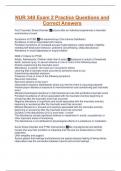NUR 340 Exam 2 Practice Questions and
Correct Answers
Post Traumatic Stress Disorder ✅occurs after an individual experiences a traumatic
event/series of event
Symptoms of PTSD ✅Re-experiencing of the trauma (flashback)
Avoidance of stimuli associated with trauma
Persistent symptoms of increased arousal (hypervigilance, easily startled, irritability,
reckless/self-destructive behavior, problems concentrating, sleep disturbance)
Alterations in mood (depressed or angry/irritable)
DSM-V Criteria for PTSD
Adults, Adolescents, Children older than 6 years ✅Exposure to actual or threatened
death, serious injury, or sexual violence in one or more of the following ways
Directly experiencing the traumatic event
Witnessing, in person, the event as it occurred to others
Learning that a traumatic event occurred to someone close to you
Experiencing repeated exposure
Presence of one or more of the following symptoms
Recurrent memories
Recurrent dreams of the event
Dissociative reactions (flashbacks) where you feel the event is recurring presently
Intense psych distress at exposure to internal/external cues symbolizing past traumatic
event
Marked physiological reactions to internal/external cues that symbolize traumatic event
Persistent avoidance of stimuli associated with the traumatic event(s) beginning or
worsening after the traumatic event has occurred
Negative alterations in cognitions and mood associated with the traumatic event(s),
beginning or worsening after the traumatic event has occurred
Marked alterations in arousal and reactivity associated with the traumatic event(s),
beginning or worsening after the traumatic event has occurred\
Duration of the disturbance (2-5) is more than 1 month
The disturbance causes significant distress or impairment in social, occupational, or
other important areas of functioning
The disturbance is not attributed to physiological effects of a substance or medication
Acute Stress Disorder and PTSD Interventions ✅Be nonjudgmental and tactfully
honest (the way their condition is impacting their life and our observations of their
response).
Offer empathy and support.
Assure patient that feelings and behaviors are typical (lessens feeling of being alone).
Help patient see the connection between trauma and current feelings.
,Help patient evaluate past behaviors in context of trauma in order to reduce guilt and
self-judgment.
Provide for safe verbalization of feelings, especially anger (process in a healthy way).
Encourage adaptive coping strategies (pts totally avoid their stressors).
Facilitate progressive review of trauma and its consequences to reduce re-experiencing
the trauma.
Encourage to establish or reestablish relationships.
Dissociative Identity Disorder ✅multiple personalities
Presence of two or more distinct personality states
Each alternate personality (alter) has own pattern of
Perceiving
Relating to and
Thinking about the self and environment
Models of Dissociative Identity Disorder ✅Posttraumatic model = occurs due to past
traumatic events
Sociocognitive model = learned cultural behavior (not organic; subconsciously highly
susceptible to other personalities)
There are no/very few cases outside the US
Neurobiological Factors of DID ✅Early/prolonged detachment from the caretaker
negatively affects the development of the limbic system
Pts w/ DID have altered communication between higher and lower brain structures due
to massive release of endogenous opioids at the time of a severe threat
One of the most primitive ego defense if dissociation
Dissociative Disorder Characteristics ✅Disruption and fragmentation in the normal
integration of feelings, behaviors, thoughts, and identity
Disruption in consciousness, memory body representation, motor control, and behavior
Dissociative Disorder Interventions ✅Help patient gain control of overwhelming
feelings and impulses through brief, direct verbal interactions.
Assist patient to build on coping strategies that helped in past traumatic
experiences("grounding techniques": taking a shower, deep breathing, touching
something soft, exercising)
Encourage patient to contact support persons who will provide comfort and
understanding.
Teach patient to avoid anxiety-producing situations that provoke dissociative behaviors.
Offer appropriate medication and other therapeutic strategies to alleviate dissociative
symptoms (possible SSRI, antidepressants, anti-anxiety, and antipsychotics; want to
avoid benzos because it could lead to dramatic memory retrieval of traumatic
suppressed events)
Provide undemanding simple routine (reduce anxiety)
Provide safe, protected environment and frequent observation
Confirm identity of pt and orient them
,Encourage pt to be independent and make own decisions about routine tasks
Assist with major decision making
Do not flood pt with data regarding past events
Provide empathetic listening
Cognitive behavioral therapy
Somatic therapy
DID Somatic Therapy ✅sensorimotor psychotherapy combines talk therapy with body-
centered interventions and movement to address dissociative symptoms. Awareness,
focusing on the present, and recognizing touch as a means of communicating are some
of the principles of this therapy
Alcohol ✅Sedative creating an initial feeling of euphoria
Decreased inhibitions
Binge-drinking versus heavy drinking
Intoxication and withdrawal
Alcohol-induced amnestic disorder (blackout)
Fetal Alcohol Syndrome ✅Peripheral neuropathy
Alcoholic myopathy and cardiomyopathy
Esophagitis, gastritis, and pancreatitis
Alcoholic hepatitis
Cirrhosis of the liver
Leukopenia
Thrombocytopenia
Cancer (head and neck)
Caffeine ✅Most widely used psychoactive substance in the world
Can result in intoxication and withdrawal
Cannabis (Marijuana) ✅(dangerous in people who are genetically predisposed to
schizophrenia)
Most widely used illegal drug in the world
Fourth most commonly used psychoactive drug in the United States after caffeine,
alcohol, and nicotine
Hallucinogen ✅Cause a profound disturbance in reality
Inhalant ✅Solvents for glues and adhesives
Propellants
Thinners
Fuels
Opioid ✅Heroin and prescription drugs
, Opoid Pharmacological Treatment ✅Methadone, buprenorphine, and naltrexone
Sedative, hypnotic and antianxiety medications ✅Benzodiazepines
Benzodiazepine-like drugs
Carbamates
Barbiturates
Barbiturate-like hypnotics
Stimulant ✅Amphetamine-type, cocaine**, or other stimulant drugs
Second only to cannabis as the most widely used illicit substances in the United States
Tobacco ✅(nicotine)
Schedule II Substance: Acute/Health Risks ✅Increased HR, BP, temp, metabolism
feelings of exhilaration
increased energy
mental alertness
Tremors
reduced appetite
irritability, anxiety, panic, paranoia
Violent behavior, psychosis
Intoxication ✅People feel superhuman while using stimulants. They feel elated,
euphoric, and sociable.
They are also hypervigilant, sensitive, anxious, tense and angry
Using a substance to excess
May manifest in different ways depending on the physiological response of the body
Individuals may be considered under the influence, intoxicated, or high
Symptoms of Intoxication include 2 or more of following ✅Respiratory depression
Chest pain
Cardiac arrhythmias
High or low BP
Tachycardia/bradycardia
Dilated pupils
Perspiration; chills
Nausea/vomiting
Weight loss
Psychomotor agitation or retardation
Weakness
Confusion
Seizures
Coma




